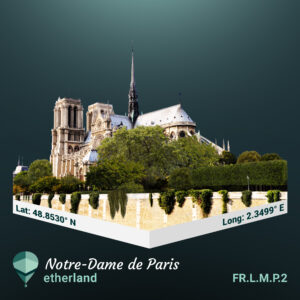
Notre-Dame de Paris, meaning ‘Our Lady of Paris’, is the cathedral church of the French capital. It sits in the very heart of the city on the Île de la Cité in the River Seine. It is widely regarded as the most impressive example of a Gothic cathedral built in Europe during the Middle Ages. Work on it was initiated in the 1160s under the patronage of the bishop of Paris, Maurice de Sully. The original structure was erected on the eastern end of the Île de la Cité on the site of two earlier churches, which in turn had been erected centuries earlier at the site of a former Roman Temple of Jupiter. The population of Paris was expanding considerably in the twelfth century, to approximately 150,000 people, and a new cathedral was needed to serve the city’s growing religious needs. The foundation stone was laid by Pope Alexander III in 1163, though construction of the enormous edifice was slow and parts of the building were still only being completed in the 1260s and 1270s, over a century after work began.
The cathedral was conceived and designed by several different master builders whose names have unfortunately been lost to the historical record. The cathedral consists of a nave and transept along which double aisles run for the congregants in the main body of the building. At the front lie the chancel, altar and ambulatory, with two chapels on the north and south sides of the transept. Several prominent statues were added subsequently, including those to St Denis and of the Virgin and Child. Perhaps the most striking features of the cathedral, though, are the three large stain glass ‘rose windows’ on the western, northern and southern sides of the cathedral, which are notable for their size. The rose on the south transept, for instance, is 12.9 metres in diameter. The cathedral measures approximately 130 metres by 48 metres and stands nearly seventy metres high in some places, notably the two massive Gothic towers at the front or western end of the cathedral erected during the early thirteenth century.
Though renovated under the patronage of King Louis XIV in the late seventeenth century, Notre-Dame fell on hard times following the French Revolution of 1789, as the revolutionaries were opposed to the Roman Catholic Church and stripped some of the riches out of the cathedral. Napoleon Bonaparte subsequently made efforts to restore Notre-Dame and his coronation as Emperor of France was held here in 1804. This rejuvenation of the building peaked in the mid-nineteenth century when the architect Eugene Viollet-le-Duc restored large parts of the building and added the iconic spire on the roof of the eastern end of the cathedral. It would have been viewed by Allied troops in the early autumn of 1944 as the liberation of Paris from the Nazis was celebrated in Notre-Dame. Thereafter in the late twentieth century the cathedral became one of France’s principal tourist sites, with over twelve million visitors annually, making it Paris’s most visited landmark. A new restoration campaign was undertaken in the 2010s, which unfortunately resulted in a massive fire on the 15th of April 2019, which destroyed the roof, including Viollet le-Duc’s spire. Repair work is underway.